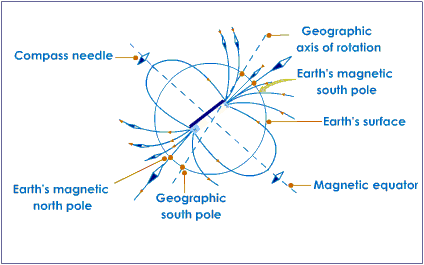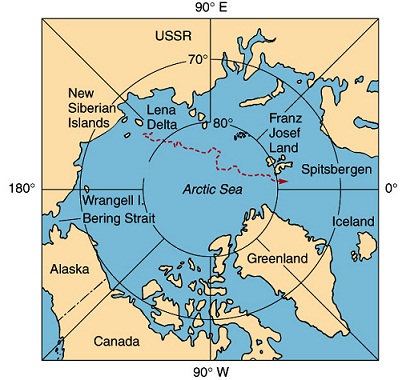Earth's magnetic field, also called as geomagnetic field, is magnetic field which extends from Earth's interior to where it meets solar wind, stream of charged particles emanating from Sun. Its magnitude at surface of Earth ranges from 25 to 65 microtesla. It is about the field of magnetic dipole tilted at angle of 10 degrees with respect to rotational axis of earth, as if there were bar magnet placed at that angle at center of Earth. Unlike a bar magnet, though, magnetic field changes over time because it is created by geodynamo
Earth's magnetic field serves to repel solar wind, whose charged particles would otherwise slip away ozone layer which protects Earth from dangerous ultraviolet radiation.
Reason why compass works is more exciting. It turns out that you can consider Earth as having enormous bar magnet buried inside. For the north end of compass to indicate toward North Pole, you have to suppose that underlying bar magnet has its south end at North Pole. If you consider the world this way, then you can see that normal opposites attract rule of magnets will cause north end of compass needle to aim toward south end of underlying bar magnet. So compass aims toward the North Pole.

To be totally correct, bar magnet doesn’t run exactly along Earth's rotational axis. It is skewed slightly off centre. This skew is known as declination, and most good maps point to what declination is in different areas. Magnetic field of Earth is quite weak on surface. After all, planet Earth is approximately 8,000 miles in diameter, so magnetic field has to travel long way to affect compass. That’s why compass requires having lightweight magnet and frictionless bearing. Or else, there just is not sufficient strength in Earth's magnetic field to turn needle.
Big bar magnet buried in core analogy works to describe why Earth has magnetic field, but clearly that is not what is actually happening. So what is phenomenon?
The Earth’s core is believed to contain mainly of molten iron (red). But at very core, pressure is so immense that this superhot iron crystallizes into solid. Cause of convection by heat radiating from core, along with rotation of Earth, causes liquid iron to move in rotational pattern. It is thought that rotational forces in liquid iron layer guide to weak magnetic forces around axis of spin.
It turns out that as the magnetic field of Earth is so weak, compass is nothing but a detector for very small magnetic fields generated by anything. That’s why we can use make use of compass to sense small magnetic field created by wire carrying current
Main characteristics
Description
Common coordinate systems utilized for demonstrating Earth's magnetic field. At any location, Earth's magnetic field can be symbolized by three-dimensional vector. A typical procedure for measuring its direction is to utilize a compass to find out direction of magnetic North.
Intensity
Intensity of field is frequently measured in gauss (G), but is usually reported in nanotesla (nT), with 1 G = 100,000 nT.
Inclination
Inclination is given by angle which can suppose values between -90° (up) to 90° (down). In northern hemisphere, field indicates downwards. It is straight down at North Magnetic Pole and rotates upwards as latitude decreases until it is horizontal (0°) at magnetic equator.
Declination
Declination is positive for eastward deviation of field relative to true north. It can be evaluated by comparing magnetic north/south heading on compass with direction of a celestial pole. Maps classically comprise information on declination as angle or small diagram illustrating relationship between magnetic north and true north.
Presently, overall geomagnetic field is becoming weaker; current strong deterioration corresponds to 10–15% reduce over last 150 years and has accelerated in past many years; geomagnetic intensity has declined almost continuously from maximum 35% above modern value achieved roughly 2,000 years ago. Rate of decrease and current strength are in normal range of variation.

The dipole component of Earth's field can reduce even while total magnetic field stays same or increases. Earth's magnetic north pole is drifting from northern Canada towards Siberia with currently accelerating rate—10 kilometres (6.2 mi) per year at starting of 20th century, up to 40 kilometres (25 mi) per year in 2003, and as then has only hastened.